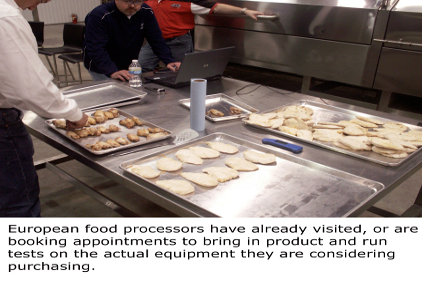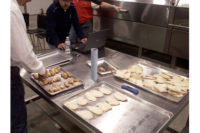Located just outside of London in Ashford, UK, the newly opened kitchen allows European food processors to test a variety of cooking and freezing options and to optimize the equipment and the process before they put down a penny. Customers from Austria, Germany, Poland, Spain, France, the UK and other European countries have already visited, or are booking appointments to bring in product – be it cooked or frozen, vegetable or meat – and run tests on the actual equipment they are considering purchasing.
The facility houses a Micro Spiral Oven, the world’s smallest spiral oven measured by its 2m X 1.5 m footprint; equipment that can smoke a ham in a minute; infrared pasteurization equipment that in less than 60 seconds extends shelf-life by more than 30% compared to other methods; a flame grill with the most ribbon burners in the industry that produce bar-marks for a flame grilled appearance; and a newly released machine called the Tunnel of Fire that can flame roast chicken in 30 seconds.
The Tunnel of Fire was a machine developed in 2010 for a Belgian food processor looking to maintain the consistency and quality of traditional flame glazed hams. The previous method for achieving a flame glaze literally involved a hand-held blow torch – a labor intensive technique that was not sustainable as the business grew.
The Tunnel of Fire was developed by Unitherm to meet the Belgian food processors need to increase production without compromising the quality of a very traditional product.
“The future of food processing machinery purchasing is going this way, where the customer can demand to go into a kitchen and actually try out their product on the machinery,” says David Howard, CEO of Unitherm Food Systems of Bristow, Okla. “Only then can they feel confident that the equipment best serves their operational parameters and expected results.”
Already recognized throughout the food processing industry for its unique heat transfer systems that maximize yields and reduce processing times, Unitherm decided to duplicate the success of its $2.5 million, 2,300-square-meter kitchen at its plant in Tulsa, Okla., that would be more accessible to European food processors.
“Our European customers want to try out their products on the machines,” says Howard, a European expatriate that now resides in Oklahoma despite being born in England and raised in Northern Ireland. “Having a test kitchen open in Europe will help move the industry forward with innovative technology that has helped some of the most successful food processors in the world.”
The combined value of the equipment in both kitchens is upwards of $12 million worth of fully operational production machines and product handling equipment that can continuously feed as many as 10 different cooking processes – steaming, blanching, broiling, baking, searing, branding, grilling, and pasteurizing; convection impingement to infrared; with gas, electric or thermal oil. Cooking temps range from below boiling point all the way to 1,300°C.
Likewise, quick cooling “crusters” have attained de rigueur status for any food-processing plant that produces meat or poultry logs. The chilling side also includes a spiral freezer and a continuous impingement freezer.
“By testing product in a kitchen with the exact kind of equipment they will be purchasing, we’re helping food processors to focus on how to improve the quality, yield and throughput of their final product in an observable, real way,” explains Howard. “Ordinarily, people visit a plant, go back and have a corporate meeting, and then purchase. But these kitchens help speed that process.”





